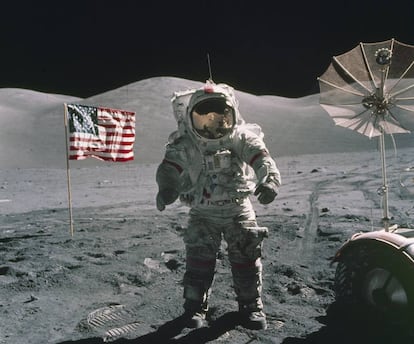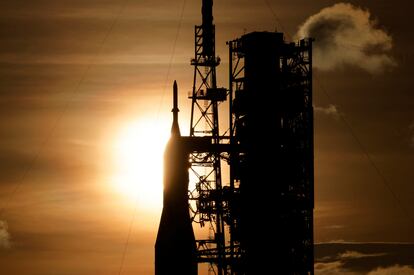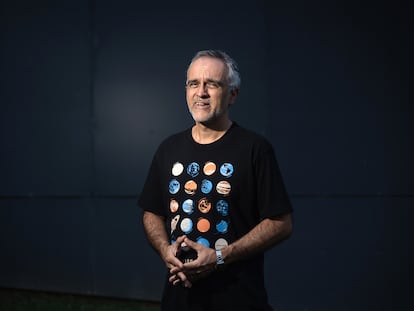NASA’s plan to return to the Moon–and stay
A memo leaked to the press details the agency’s plans to “reconquer” space

At the end of 2017, coinciding with the 45th anniversary of the last flight of the Apollo program to the Moon, former US President Donald Trump signed a presidential directive that urged NASA to renew its efforts to return to the Moon as soon as possible. He did not set a date, but just a year later, former Vice President Mike Pence did: 2024. He was presumably counting on an eventual re-election of Trump, who would attempt to repeat John F. Kennedy’s achievement from half a century earlier. But the deadline was too tight. NASA had neither the right ship nor the right rocket, nor a concrete plan of how to do it. The Apollo program had been conceived essentially as a gesture for national prestige, with limited scientific ambitions. A return to the Moon would be an exploration mission with broader objectives than just planting the ceremonial flags. Thus was born the Artemis program, NASA’s plan to reconquer the Moon.
The initiative is named after Apollo’s twin sister in Greek mythology. Its delays began to accumulate almost as soon as the plan was conceived. NASA never officially revealed its intentions beyond the first three flights: the first would depart without a crew; the second would include astronauts, who would orbit around the Moon; and the third would touch down on its surface. The landing was scheduled for 2025, which many experts considered an impossible deadline.
The lunar spacecraft Orion and its carrier rocket, the SLS, have not yet flown. Both should debut this summer. The Orion is an orbital capsule, which cannot descend to the Moon’s surface. The mission has been entrusted to Space X’s StarShip, which presented the best financial offer.
On paper, the Starship seems as promising as it is revolutionary: a freighter, an orbital spacecraft with capacity for dozens of crew members, a suborbital vehicle for transporting passengers, an in-flight refueling tanker, a landing capsule on the Moon and—finally—a Mars explorer. So far, though, its prototype has not reached more than 15 kilometers in height, and it has only managed to complete one successful landing.

A draft of the plans for future flights has just appeared, leaked to the media outlet Ars Technica. Artemis 4 would be used to begin construction of an orbital station around the Moon, which would involve substantial European cooperation. That would take place between 2027 and 2029, at the soonest, and would require at least two or three more flights.
NASA contemplates five more Artemis missions in the next decade. They plan to take elements to the Moon to build a small permanent base, as well as a pressurized vehicle that would be something like a rolling laboratory similar to the one from the movie Mars. The last planned flight is the Artemis 9, scheduled—with great optimism—for 2034.
The plan’s greatest obstacle is its staggering cost. It is not clear that Washington will agree to cover bills that will exceed $4 billion dollars per flight, almost 20% of NASA’s total current budget. And questions are already being raised concerning the use of the new SLS superrocket, now resting on its ramp at the Kennedy Center.
The process of designing the SLS began before Space X demonstrated the possibility of recovering the rockets for reuse. Since then, Elon Musk’s company has recycled some of its launchers in more than a dozen flights, consequently decreasing the cost of each operation. When it takes off, the SLS will be a “throwaway” rocket: its four main engines—harvested from old space shuttles—will go to the bottom of the Atlantic.
Since it used engines, center tank and side throttles all from the Shuttle program, the SLS should have been cheaper than the Saturn 5 of the 1960s. But it wasn’t. Each moon rocket in the Apollo program cost about $1.4 billion in current dollars; each shuttle, about $1.5 billion. The SLS will start at $2.2 billion, without counting its astronomical development costs. For future lunar operations, an even more powerful version will be necessary.
SLS is not the only Achilles heel of the Artemis program. Many believe that the Gateway base around the Moon makes less sense than providing a secure high-altitude mooring point for the Orion capsule, whose engines would not allow it to pull itself out of a low lunar orbit. The future StarShip (known as HLS: Human Landing System) will also have to dock on the orbital station, but it will be much larger than the Gateway itself, and the two structures would have numerous duplicated systems. It is not clear whether the cost and time spent building the station are justifiable and whether a cheaper alternative is possible.
Perhaps the answer should be sought not in technology but in politics. Twelve years ago, the SLS program was designed to appease large aerospace contractors who were concerned about the end of shuttle operations and the subsequent job loss. Almost all the states got a more or less important piece of the pie, depending on the negotiating skills of their representatives in Washington. All together, they received $24 billion in development expenses alone.
We are no longer in Kennedy’s times, when going to the Moon was a matter of national pride. Now it is just a matter of business.
Tu suscripción se está usando en otro dispositivo
¿Quieres añadir otro usuario a tu suscripción?
Si continúas leyendo en este dispositivo, no se podrá leer en el otro.
FlechaTu suscripción se está usando en otro dispositivo y solo puedes acceder a EL PAÍS desde un dispositivo a la vez.
Si quieres compartir tu cuenta, cambia tu suscripción a la modalidad Premium, así podrás añadir otro usuario. Cada uno accederá con su propia cuenta de email, lo que os permitirá personalizar vuestra experiencia en EL PAÍS.
¿Tienes una suscripción de empresa? Accede aquí para contratar más cuentas.
En el caso de no saber quién está usando tu cuenta, te recomendamos cambiar tu contraseña aquí.
Si decides continuar compartiendo tu cuenta, este mensaje se mostrará en tu dispositivo y en el de la otra persona que está usando tu cuenta de forma indefinida, afectando a tu experiencia de lectura. Puedes consultar aquí los términos y condiciones de la suscripción digital.











































